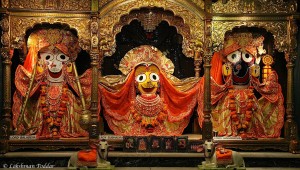From K Jayadeva Das:
Between the first release of the MacMillan edition and the year 1977 in which Srila Prabhupada disappeared there would have been many reprint of Bhagavad Gita As it is, why these changes were not incorporated at those times?
Where is the documentary evidence that Srila Prabhupada wanted those changes made to his Bhagavad Gita As it is?
Now justifying the changes is like argument between lawyers where the more powerful in arguing wins no matter what the truth is.
We don't need sophisticated flowery language nor the best use of the English language. For us the words come out from a pure devotee is enough that will do everything required spiritually. Please leave us with the original manuscript, we don't want the book written in your best Language.
Making changes is not the issue, but it should have been approved by the Acharya Srila Prabhupada. Now how does one know whether the changes are authorized? Leaving the decision to the readers is not acceptable, because we are not pure devotees.
The book should have been left "As it is" because even without those so called 'corrections' the potency of a pure devotee Srila Prabhupada's words will never be diminished and there is no doubts that the readers' heart will be cleansed in spite of the absence so called corrections.
If at all the changes were made, it should NOT have been marketed in the original name used by Srila Prabhupada, instead it should have been sold with Bhagavad Gita with the devotee who made the changes as the author.
Relevant quote
http://bbtedit.com/prabhupada_order_to_revise
Srila Prabhupāda knew there were mistakes in his books, and he wanted those mistakes fixed. Consider this excerpt from a class in Hawaii (January 1, 1974):
 HH Giriraj Swami's wonderful answer! Lord Krishna and His energies exist eternally, simultaneoulsy, but because Krishna is primary and His energies are subordinate, we say that they come from Him. For example, we say that the sunshine comes from the sun, because the sunshine is secondary to the sun, but as long as the sun has existed, the sunshine has also existed.
HH Giriraj Swami's wonderful answer! Lord Krishna and His energies exist eternally, simultaneoulsy, but because Krishna is primary and His energies are subordinate, we say that they come from Him. For example, we say that the sunshine comes from the sun, because the sunshine is secondary to the sun, but as long as the sun has existed, the sunshine has also existed. 


 One of the kids was asking if the lady close to Krishna is His girlfriend!
One of the kids was asking if the lady close to Krishna is His girlfriend! 
 Chanting and dancing!
Chanting and dancing! 
 Part of the concert with Aditi-Dukha ha Prabhu and Symphony orchestra. Arranged by Shri Harinam Mandir, ISKCON, Tallinn, Estonia.
Part of the concert with Aditi-Dukha ha Prabhu and Symphony orchestra. Arranged by Shri Harinam Mandir, ISKCON, Tallinn, Estonia.  H G Harigaura Prabhu president of ISKCON Mentakab organised Harinam at Mentakab on 19 April 2014. Mentakab is a town which is around 120km away from Kuala Lumpur. This was the first ever harinam organised at mentakab. Deities of Sita Ram Lakshman Hanuman were taken on a palanquin procession in and around the housing areas of Mentakab. 40 residents did offering for Their Lordships and 50 devotees attended the harinam. The Harinam which continued for 3 hours started and ended at Sriman Arumugam’s house who is an active member of Mentakab centre. H G Siva Caitanya prabhu gave a class on chanting and Bhagavad Gita at the end of the harinam and enlightened each and every one who were present.
H G Harigaura Prabhu president of ISKCON Mentakab organised Harinam at Mentakab on 19 April 2014. Mentakab is a town which is around 120km away from Kuala Lumpur. This was the first ever harinam organised at mentakab. Deities of Sita Ram Lakshman Hanuman were taken on a palanquin procession in and around the housing areas of Mentakab. 40 residents did offering for Their Lordships and 50 devotees attended the harinam. The Harinam which continued for 3 hours started and ended at Sriman Arumugam’s house who is an active member of Mentakab centre. H G Siva Caitanya prabhu gave a class on chanting and Bhagavad Gita at the end of the harinam and enlightened each and every one who were present.